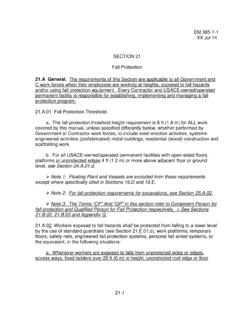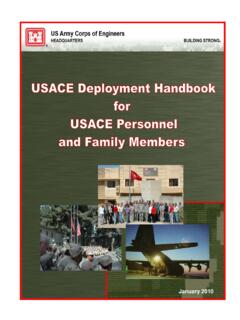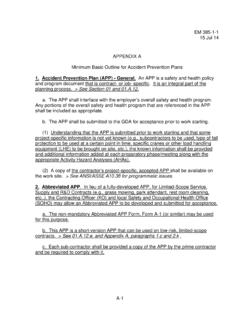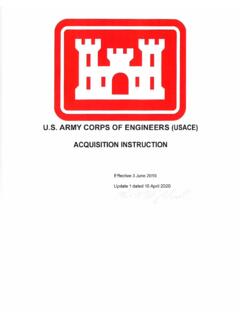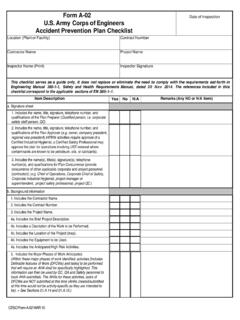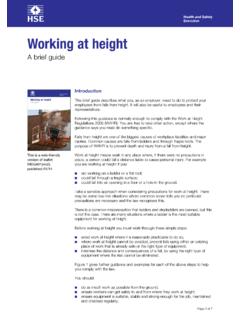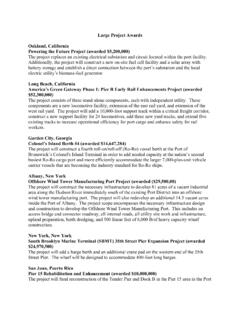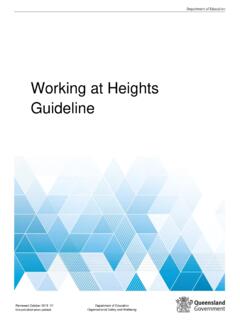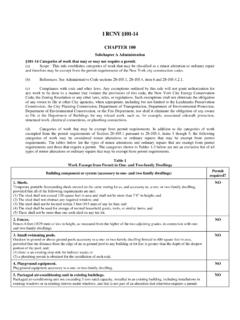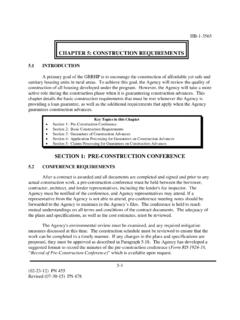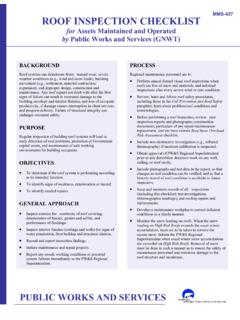Transcription of EM385-1-1 Section 16 TOCFINAL
1 EM 385-1-1 30 Nov 14 16-i Section 16 TABLE OF CONTENTS Load Handling Equipment (LHE) Section : Page General .. 16-1 Personnel Qualifications .. 16-7 Classification of USACE LHE and Training of USACE Operators .. 16-14 Inspection Criteria for Load Handling Equipment (LHE) .. 16-16 Safety Devices and Operational Aids .. 16-19 Testing .. 16-23 Operation .. 16-26 Critical Lifts .. 16-36 Environmental Considerations .. 16-38 Lattice, Hydraulic, Crawler-, Truck-, Wheel-, and Ringer-Mounted Cranes .. 16-38 Portal, Tower, and Pillar Cranes.
2 16-40 Floating Cranes/Derricks, Crane Barges, and Auxiliary Shipboard-Mounted Cranes .. 16-42 Overhead and Gantry Cranes .. 16-52 Monorails and Under Hung Cranes .. 16-53 Derricks .. 16-53 Handling Loads Suspended from Rotorcraft .. 16-54 Powered Industrial Trucks (PITs)/Telehandlers .. 16-56 Pile Driving Operations .. 16-56 EM 385-1-1 30 Nov 14 16-ii Hydraulic Excavators, Wheel/Track/Backhoe Loaders Used to Hoist Loads with Rigging .. 16-60 LHE-Supported Personnel (Work) Platforms .. 16-62 Base-Mounted Drum Hoists Used to Hoist Personnel, Guided and Non-Guided Worker s Hoists (Air Tuggers).
3 16-69 Figures: 16-1 Crane Hand Signals .. 16-74 16-2 Dedicated Pile Driver, Example .. 16-83 16-3 Non-Dedicated Pile Driver, Example .. 16-84 16-4 Crane Hand Signal Overhead and Gantry .. 16-85 Forms: 16-1 Certificate of Compliance for LHE and Rigging .. 16-71 16-2 Standard Pre-Lift Crane Plan/Checklist .. 16-72 16-3 Critical Lift Plan .. 16-77 Tables: 16-1 Minimum Clearance from Energized Overhead Electric Lines .. 16-35 16-2 Minimum Clearance Distance from Energized Overhead Electric Lines While Traveling with No Load .. 16-35 EM 385-1-1 30 Nov 14 16-iii THIS PAGE INTENTIONALLY LEFT BLANK EM 385-1-1 30 Nov 14 16-1 Section 16 Load Handling Equipment (LHE) General.
4 The requirements of this Section are applicable to all load handling equipment (LHE) to include cranes, derricks, hoists and power-operated equipment that can be used to raise, lower and/or horizontally move a suspended load. Exemptions. All requirements of Section 16 apply except as noted below: a. Affixed A-frames performing anchor handling or dredge-related operations (ONLY) with a vessel or barge are exempt from Sections and ; In addition, see Section for equipment-specific requirements; b. Base-mounted drum hoists used to hoist personnel, guided and non-guided, whether powered by internal combustion engine, electric motor or other prime mover, to include air tuggers) are exempt from Sections ; In addition, see Section for equipment-specific requirements; c.
5 Digger derricks used for utility/pole installation; d. Vehicle-mounted aerial devices ( , Bucket Trucks) - See Section Vehicle-Mounted Elevating and Rotating Work Platforms (Aerial Devices/Lifts) and also Section , Elevating Aerial Work Platforms (AWPs); e. Hydraulic Excavators, Wheeled/Trackhoe/Backhoe loaders used to hoist loads with rigging are exempt from the requirements in Sections through (crane operator certifications) only. Rigger qualifications still apply, per Section See Section for equipment-specific requirements; f. Powered Industrial Trucks (PIT s, , Forklifts)/Telehandlers when configured to hoist and lower (by means of a winch or hook) and horizontally move a suspended (rigged) load are exempt from the requirements in through (crane operator certifications) only, UNLESS this equipment is used to hoist/lift personnel.
6 This activity is considered a Critical Lift and as such, requires a physical examination for the operator (per and additional criteria per Section Rigger qualifications still apply, per Section > See Section for equipment-specific requirements; g. Machinery that hoists by using a come-a-long or chainfall (whether human-, air- or electric- powered, chain or wire-rope type); EM 385-1-1 30 Nov 14 16-2 h. Operators of equipment with a maximum manufacturer-rated hoisting/lifting capacity of 2,000 pounds (907 kg) or less, are exempt from the operator qualification or certification requirements in Sections through only.)
7 In addition, this equipment may not be used to hoist personnel; i. Hoist Operators are exempt from Section , Physical Examination requirements UNLESS this equipment is used to hoist/lift personnel. This activity is considered a Critical Lift and requires a physical examination for the operator. In addition, all Class II operators that will be hoisting personnel shall be trained at a minimum, in the requirements listed in Section > See also Section , Note 3 and Section ; j. Dedicated drilling rigs; k. Tree trimming and removal work; l. Gin poles when used for the erection of communication towers; m.
8 Helicopter cranes are exempt from Sections and ; n. Stacker cranes; o. Mechanic s Trucks with a hoisting device when used in activities related to maintenance and repair; p. Material Delivery. (1) Articulating/knuckle-boom truck cranes that deliver material to a construction site when used to transfer materials from the truck crane to the ground, without arranging the materials in a particular sequence for hoisting. (2) Articulating/knuckle-boom truck cranes that deliver material to a construction site when the crane is used to transfer building supply sheet goods or building supply packaged materials from the truck crane onto a structure, using a fork/cradle at the end of the boom, but only when the truck crane is equipped with a properly functioning automatic overload prevention device.
9 Such sheet goods or packaged materials include, but are not limited to: sheets of sheet rock, sheets of plywood, bags of cement, sheets or packages of roofing shingles, and rolls of roofing felt. (3) This exclusion does not apply when: (a) The articulating/knuckle-boom crane is used to hold, support or stabilize the material to facilitate a construction activity, such as holding material in place while it is attached to the structure; EM 385-1-1 30 Nov 14 16-3 (b) The material being handled by the articulating/knuckle-boom crane is a prefabricated component. Such prefabricated components include, but are not limited to: precast concrete members or panels, roof trusses (wooden, cold-formed metal, steel, or other material), prefabricated building sections such as, but not limited to: floor panels, wall panels, roof panels, roof structures, or similar items; (c) The material being handled by the crane is a structural steel member (for example, steel joists, beams, columns, steel decking (bundled or unbundled) or a component of a systems-engineered metal building.)
10 Certification of Compliance (COC). Contractors shall submit a COC for each piece of LHE prior to being brought on site. The COC shall be submitted to the GDA for acceptance. > See Form 16-1, Certificate Of Compliance. a. The COC states that the LHE and the rigging equipment meets applicable regulations (to include inspections and tests) as required by the manufacturers and the requirements of this manual. It must be signed by a Competent Person for Crane and Rigging. > See Appendix Q. b. COC shall be posted on the LHE. Standard Lift Plan (SLP). All lifts must be planned to avoid situations where the operator cannot maintain safe control of the lift.
